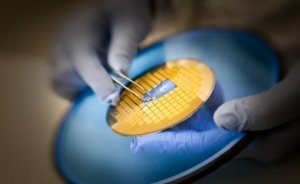Oct 6 2017
With research headed by University of Queensland bioscience experts and funding provided by the World Health Organisation (WHO), the efforts to rid the world of polio have indeed taken another major step.
 The Nanopatch targets cells in the skin’s outer layers (Credit: University of Queensland)
The Nanopatch targets cells in the skin’s outer layers (Credit: University of Queensland)
A new study of the Nanopatch – a microscopic vaccine delivery platform initially developed by UQ Researchers - has demonstrated that the device more effectively combats the polio virus than syringes and needles.
Professor Paul Young, Head of UQ’s School of Chemistry and Molecular Biosciences, stated that the innovation provided the next step in consigning polio to history.
“Polio was one of the most dreaded childhood diseases of the 20th century, resulting in limb disfigurement and irreversible paralysis in tens of millions of cases,” Professor Young said.
This most recent study showed the Nanopatch enhanced responses to all three types of inactivated poliovirus vaccines (IPV) – a necessary advancement from using the current live oral vaccine. We are extremely grateful to the WHO for providing funding to Vaxxas Pty Ltd, the biotechnology company commercialising the Nanopatch. The support specifically assists pre-clinical studies and good manufacturing practices.
Professor Paul Young, Head of the School of Chemistry and Molecular Biosciences, The University of Queensland
Patch inventor Professor Mark Kendall stated that the study displayed a main advantage of the Nanopatch.
“It targets the abundant immune cell populations in the skin’s outer layers, rather than muscle, resulting in a more efficient vaccine delivery system,” Professor Kendall said.
The ease of administration, coupled with dose reduction observed in this study suggests that the Nanopatch could facilitate inexpensive vaccination of inactivated poliovirus vaccines.
Professor Mark Kendall, Patch inventor
According to Dr David Muller, UQ Australian Institute for Biotechnology and Nanotechnology Researcher, successfully translating the dose could dramatically bring down the cost.
“A simple, easy-to-administer polio Nanopatch vaccine could increase the availability of the IPV vaccine and facilitate its administration in door-to-door and mass vaccination campaigns,” said Dr Muller.
As recently as 1988, more than 350,000 cases occurred every year in more than 125 endemic countries. Concerted efforts to eradicate the disease have reduced incidence by more than 99 per cent. Efforts are being intensified to eradicate the remaining strains of transmission once and for all.
Dr David Muller, Researcher, Australian Institute for Biotechnology and Nanotechnology, The University of Queensland
Data obtained from the study boosts efforts by Vaxxas - established by UQ’s commercialization company UniQuest – in order to bring the technology to use for human vaccinations.
“The research we are undertaking in conjunction with UQ and WHO can improve the reach of life-saving vaccines to children everywhere,” Vaxxas Chief Executive Officer David Hoey said.